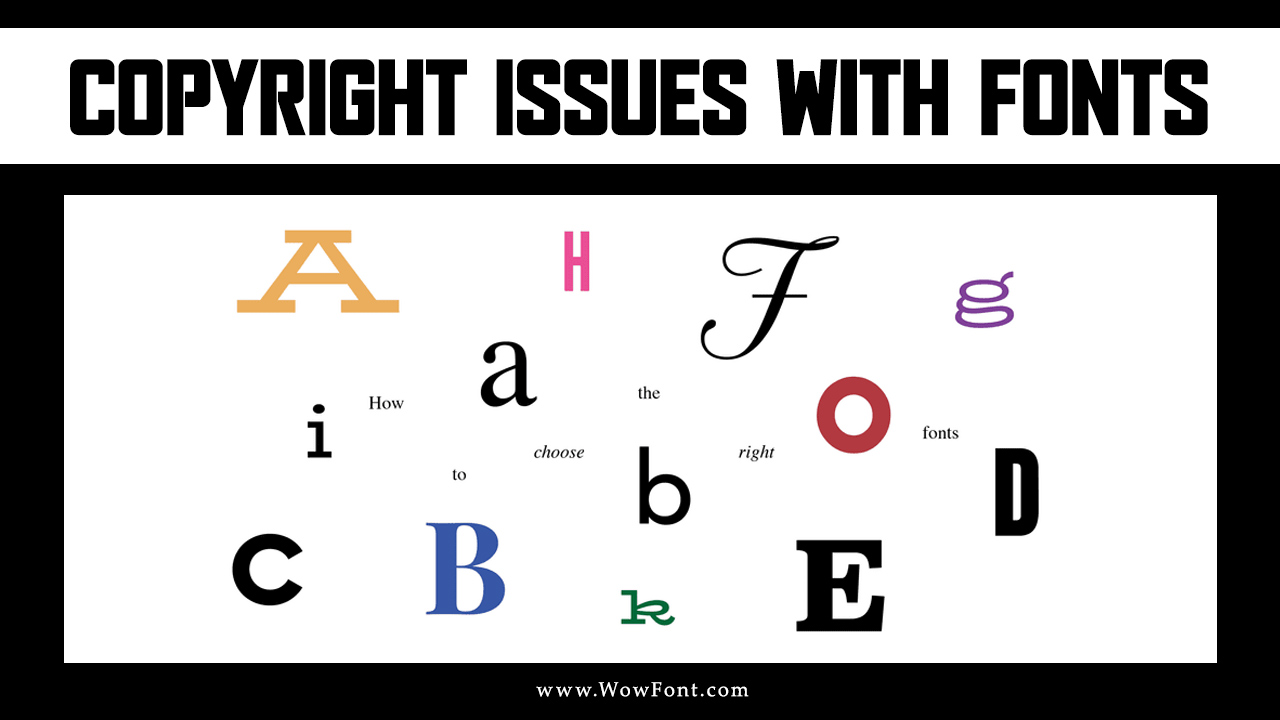In the design world, fonts are essential for communication and branding, but the legal landscape surrounding font usage can be complex. Copyright law plays a significant role in protecting the intellectual property of font creators and font foundries.
This article delves into the copyright issues associated with fonts, including licensing agreements, copyright infringement, and the rights of copyright holders.

Understanding Copyright And Fonts

- The Copyright Act
- Intellectual Property
The Copyright Act provides legal protection for original works, granting creators exclusive rights to reproduce, distribute, and display their work. In the context of fonts, this protection extends to the digital font software that enables typefaces to be displayed and used. However, the copyright status of the design itself, such as the unique glyphs in a typeface, varies depending on the jurisdiction.
Font Licensing And Licensed Fonts
When using fonts, understanding font licensing is crucial. A font license defines how a font can be used, including restrictions on installation, distribution, and modifications. Fonts may be classified as licensed fonts, free fonts, or custom fonts, each with its own set of usage rights.
Licensed fonts require users to enter into a licensing agreement with the copyright owner or font foundry, while free fonts may allow for more unrestricted usage—though this is not always the case.
Copyright Protection And Font Usage
- Licensing Agreements
To avoid copyright infringement, users must carefully adhere to licensing agreements associated with the fonts they use. A licensing agreement outlines the terms under which you can use a font. This specifies whether you can install it on multiple devices, use it in web design, or incorporate it into commercial products. Failure to comply with these terms may lead to claims of font infringement by the copyright holder.
Common Issues with Unlicensed Fonts
- Legal liability for copyright infringement.
- Financial penalties can accumulate quickly.
- Damaged brand reputation follows misuse.
- Limited rights for unlicensed use.
- Incompatibility issues across platforms.
- No access to customer support.
- Ethical concerns about font piracy.
- Fonts may be seized unexpectedly.
Using unlicensed fonts can result in significant legal risks. Many designers unknowingly use fonts without proper licenses, believing them to be free. However, even fonts labeled as “free” may come with restrictions that can lead to copyright issues. It’s essential to verify the licensing terms and ensure compliance to protect against potential copyright infringement claims.
The Role Of Font Foundries And Copyright Holders

Font Foundries and Their Rights: Font foundries are organizations that create and distribute fonts. They hold the copyright for the font software, granting them intellectual property rights over its usage. Foundries invest considerable resources into typeface design, and they rely on licensing agreements to monetize their creations while protecting their rights.
Copyright Holders and Infringement: The copyright holder of a font has the exclusive right to enforce their intellectual property rights. This includes taking action against unauthorized use, which can include issuing cease-and-desist letters or pursuing legal action for copyright infringement. Infringement can occur when someone uses a copyrighted font without permission or fails to comply with the terms of a licensing agreement.
Custom Fonts And Open Fonts
Open fonts, such as those licensed under the SIL Open Font License, provide an alternative to traditional font licensing. These fonts are often freely available for use and modification, allowing designers to integrate them into their projects without the concerns typically associated with copyright infringement. However, it’s still important to read and understand the specific licensing terms, as they can vary significantly.
( The Challenge Of Custom Fonts? )
Custom fonts, created specifically for a brand or project, also come with their own set of copyright issues. Designers must ensure that their contracts explicitly outline the ownership and usage rights for these fonts. Without clear agreements, copyright disputes can arise, leading to potential legal challenges.
Protection Beyond Copyright
In addition to copyright, some font creators may seek design patents to protect their unique typeface designs. A design patent grants exclusive rights to the ornamental design of a functional item, which can include typefaces. However, obtaining a design patent can be a lengthy and expensive process, making it less common in the font industry.
Balancing Rights And Usage
Navigating the complex landscape of font copyright requires a careful balance between the rights of font creators and the needs of designers and businesses. Understanding the legal implications of font usage, the importance of licensing agreements, and the potential for infringement is essential for anyone involved in the design process.
Conclusion
Understanding the copyright issues surrounding fonts is vital for designers and businesses alike. By adhering to licensing agreements, being aware of copyright protections, and respecting the rights of copyright holders, you can navigate the legal complexities of font usage while fostering a creative and compliant design environment. Always consult with legal experts when in doubt to ensure that you are on solid legal ground in your font usage.
FAQs About Copyright Issues With Fonts
1.What Is A Font License?
A font license is a legal agreement that specifies how a font can be used, including restrictions on distribution, installation, and modifications.
2.Can I Use Free Fonts Commercially?
Not all free fonts are available for commercial use. Always check the licensing terms to ensure compliance.
3.What Happens If I Use An Unlicensed Font?
Using an unlicensed font can lead to copyright infringement claims, which may result in legal action from the copyright holder.
4.What Is The SIL Open Font License?
The SIL Open Font License is a widely used open font license that allows users to use, modify, and distribute fonts freely, subject to specific conditions.
5.How Can I Protect My Custom Font Design?
To protect a custom font design, ensure that your contract with the client clearly outlines ownership rights and usage permissions.


Leave a Comment